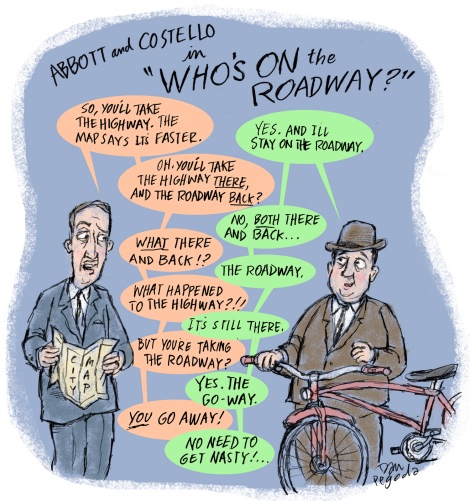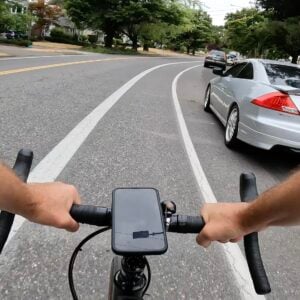
(Illustration by Dan Pegoda/Animated Traffic Law Center for BikePortland.org)
It’s a given (apart from a few exceptions) that when riding a bicycle on a street it’s to be operated on the far right side of the roadway. But what exactly is meant by “roadway”?
ORS 801.450 defines roadway as:
“… the portion of a highway that is improved, designed or ordinarily used for vehicular travel, exclusive of the shoulder. In the event a highway includes two or more separate roadways the term “roadway” shall refer to any such roadway separately, but not to all such roadways collectively.”
What this means is that the legal positioning of someone bicycling on the road will vary. In other words, “… close as practicable to the right curb or edge of the roadway” can look very different depending on the design of the street.
First; some basics. “Highway” is that area spanning from curb to curb or shoulder edge to shoulder edge. “Roadway” refers to the lanes of traffic. Think of roadway as the “go-way,” that area of vehicular movement. A crude analogy: “highway” as your arm, “roadway” as its arteries.
As a general rule a roadway does not include that area of a street where parking is permitted. A roadway is restricted to the travel lane(s).
What does this mean to people who ride bikes? Technically, while bicycling, you never have to move into that section of a highway allotted for parking to allow another vehicle to pass. To do so would mean to move off the roadway — which a bicycle operator is never required to do.
But don’t take the implications of this definition too literally because it doesn’t always fit.
Consider the example of a bus stop in a no parking zone or streets where parking is allowed only part of the time. Not moving over into the parking zone when able to do so safely may be neither the safest nor wisest choice you can make.
Traffic law is an ever-evolving process of catching up to infrastructural and transportation change. It’s a hodgepodge of laws more expressive of its parts than of a coherent whole. The result is it fails to sufficiently address many situations encountered on the streets — especially when bikes and cars mix.
Road users of all types are often left to find solutions on their own (hence, the “due care” law).
All road users need to understand their rights and duties. Just as important is the understanding that those rights and duties are not comprehensive. In some situations, in courtesy and selflessness rather than the law, resides the answer.
— Bike Law 101 appears twice a month thanks to the generous support of West End Bikes PDX (corner of 11th and SW Stark in downtown Portland). It’s written by Karen Lally and Kurt Jansen of the non-profit Animated Traffic Law Center based in Eugene, Oregon. For more info on bike law, browse the Bike Law 101 archives








Thanks for reading.
BikePortland has served this community with independent community journalism since 2005. We rely on subscriptions from readers like you to survive. Your financial support is vital in keeping this valuable resource alive and well.
Please subscribe today to strengthen and expand our work.
Nice drawing, classic skit: for those of us who grew up on Looney Toons we owe it to ourselves to pay homage to their progenitors. `sides sometimes the original is better.
Abbott and Costello perform the classic “Who’s on first?”: http://www.youtube.com/watch?v=sShMA85pv8M
… or : “highway” as the width of the hallway in you house from wall to wall, “roadway” as the part of the carpet that gets worn down due to foot traffic.
It is reasonable to say that the entire width is the hallway/highway but there is only so much of that width that can be safely used while carrying a tray of drinks/driving by at speeds where you can’t compensate for lateral anomalies.
As such it is with the highway. Cyclists travel slower than automotive traffic (usually) and are better able to react to unforeseen issues due to lower inertia. Conversely all but the most skilled cyclist needs a wider travel width than is belied by the width of their tires. Also, two wheeled vehicles, and especially those with narrow round profile tires, are more susceptible to road conditions that are of no concern to the average auto driver.
The average auto driver, which in the USA is most often a non-cyclist, has no awareness or familiarity with the surface conditions that vex our travels seeing only the hazard caused by being in front of their vehicle. They common sense tells the average Joe that we cyclists have no reason to travel in the road because the only danger they see is from their own vehicle.
Always comes back to education, doesn’t it?
Wow, great info. This is particularly useful to know for Sandy…where there is a lot of unused parking space that I sometimes don’t ride in due to the changing roadway (and freeway!) width. I got yelled at for it once. This also supports the “Ride in a straight line/don’t weave in and out of parked cars” rule as demonstrated in the Oregon DMV bicyclist manual on page 5. http://www.oregon.gov/ODOT/HWY/BIKEPED/docs/bike_manual.pdf
What I found interesting is the part that we don’t have to ride off the roadway, i.e., on the shoulder. I am not sure how that would work on country roads, but then we have the law that protects us because vehicles have to leave enough room to pass with hitting us if we were to fall, pretty much a lane.
I also found the idea that we can refuse to ride in the parking area even if it does not have parked vehicles. I will ride in such an area if I can see at least one block where it is free, but will not duck and weave to satisfy drivers. I also wonder about the legal aspects if you are hit while riding in a parking area. Could the driver claim that you were not in the roadway therefore were riding incorrectly? And if you are riding on a road that has a speed of 35MPH or more you probably should ride in the lane, although right of center, so that vehicles have to move into the other lane to pass safely given the rule about passing?
No, it’s NOT “a given (apart from a few exceptions) that when riding a bicycle on a street it’s to be operated on the far right side of the roadway.”
Since one of the few exceptions is whenever the lane “is too narrow for a bicycle and vehicle to travel safely side by side”, which effectively means the lane has to be at least 14′ feet wide (by conservative assumptions and simple math), and most roads don’t have lanes that are that wide, the requirement of 814.430 for cyclists to travel “as close as practicable to the right” actually RARELY applies in practice.
https://www.oregonlaws.org/ors/2007/814.430
Why this is such a big secret I don’t know.
Join Cyclists are Drivers! on Facebook!
http://www.facebook.com/home.php?sk=group_244724264939
Since when is it ‘a given (except for a few exceptions)’ to ride to the far right? I’ve never heard of such a rule in any state. Most state laws expect a cyclist generally to ride to the left of the gutter where debris is often found. Often that is 3 or 4ft out into the roadway.
If the parking lane has no cars in it – are bicycles required to move into the parking lane area out of the the travel lane and be at the “3 feet” from the curb rule? I’ve had Tri-met buses almost run me over because the driver felt I needed to be 3 from the curb. A dangerous way for a Tri-met driver to prove a point, but that is they way some bus drivers think. Is the parking lane considered a required travel lane for bicycles if there are no parked cars?
Ian, Oregon state law says that a cyclist must right as far to the right as is practicable, except on a one way street where a cyclist can ride as far to the left as practicable; also when approaching a left turn, a cyclist is allowed/required to move into the turn lane (much like a car does).
Also, in Oregon, cyclists are required to use the bike lane if there is one present but are allowed to leave it to avoid hazards such as slower cyclists, debris/unsafe road conditions, when turning off the current road, etc. Generally, the bike lane is to the right of the travel lane. Except in special situations which I don’t think we have much of here (contra-flow lanes, left-side bike lanes, etc).
I’m not sure what you’re confused about; could you please expand your comment?
I’ve read the law, and the thing about it is that it does NOT say, as this article asserts, that cyclists must ride ‘on the far right of the roadway’. The law says (as you say) that cyclists should operate ‘as far right as practicable’ – a very different thing.
In practice (or as is ‘practicable’), the exceptions to riding far right are so many, so common and so varied that they essentially make the supposed rule of ‘ride to the right’ an exception in itself. The biggest exception – the one that should be the rule – is the one about avoiding debris or poor road surface conditions (pavement cracks, grates, potholes, sand etc.). In practice, riding as far right as practicable means riding about 3-4ft out from the curb. No cyclist can ride ‘on the far right side of the roadway’ without endangering him/herself
My overriding point is that this idea that cyclists should ride ‘far to the right’ is a fallacy. There is no such rule.
ORS 814.430, Improper use of lanes covers riding on the right side of the roadway, and also allowing the left on one-way streets. This is the statute which allows bikes to take a position closer to the center, thus “taking the lane,” as it were.
http://www.leg.state.or.us/ors/814.html
814.430 Improper use of lanes; exceptions; penalty. (1) A person commits the offense of improper use of lanes by a bicycle if the person is operating a bicycle on a roadway at less than the normal speed of traffic using the roadway at that time and place under the existing conditions and the person does not ride as close as practicable to the right curb or edge of the roadway.
Good post, though it could have been a bit clearer. This double-negative in your post is confusing: “Not moving over into the parking zone when able to do so safely may be neither the safest nor wisest choice you can make.”
Do you mean “Moving over into the parking zone when able to do so safely may be the safest or wisest choice you can make?” That’s the meaning I get from your sentence.
If that is your meaning, I disagree. First, ORS 814.430 repeatedly refers to operating a bicycle in the roadway. The parking zone is not part of the roadway, as you emphasized in the post, even if it is vacant.
My bicycle is a vehicle. As I do with all vehicles that I operate, I drive it in a straight line, in the roadway, in order to be as predictable and visible as possible to the other vehicle drivers on the roadway. I obey traffic signals and right-of-way rules, and I signal my turns, just as any other vehicle driver should do.
Do traffic signals still apply if you’re not technically on the roadway like at the T intersections along Naito Parkway?
Does this mean that bikes cannot ride side by side because they are not to the right? What if they are riding side by side in a bike lane?
I liked the cartoon. That says a lot as many of them I don’t find amusing.
And even that only applies when the lane is wide enough to safely share, which generally means at least 14′ in width, which is very rare.
I expanded on this 2 days ago but that post has not been approved by moderators.
The main element is that one of the exceptions is when the lane is too narrow to be safely shared side-by-side – which is true on almost all roads. That is, very few roads have lanes that 14′ feet or more in width, which is really the minimum for safe side-by-side sharing. That means the whole requirement to keep right does not apply on most roads.
On portions of Willamette Street (just south of downtown) in Eugene, there are bike lanes, but they are so narrow that you must ride out in the travel (“car”) lane if you want to avoid getting doored. Needless to say, this creates bad feeling among motorists, but screw them. Better their temper lost than my life.